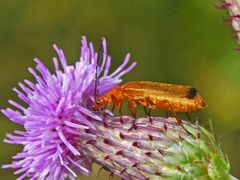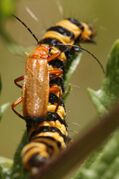Biology:Common red soldier beetle
| Common red soldier beetle | |
|---|---|

| |
| Scientific classification | |
| Domain: | Eukaryota |
| Kingdom: | Animalia |
| Phylum: | Arthropoda |
| Class: | Insecta |
| Order: | Coleoptera |
| Family: | Cantharidae |
| Subfamily: | Cantharinae |
| Tribe: | Cantharini |
| Genus: | Rhagonycha |
| Species: | R. fulva
|
| Binomial name | |
| Rhagonycha fulva | |
| Synonyms[2] | |
|
List
| |
File:Rhagonycha fulva, copula.ogv The common red soldier beetle (Rhagonycha fulva), also misleadingly known as the bloodsucker beetle,[3][4] and popularly known in England as the hogweed bonking beetle[5] is a species of soldier beetle (Cantharidae).
Taxonomy
Rhagonycha fulva was first described by Giovanni Antonio Scopoli in 1763 in Entomologia Carniolica as Cantharis fulva.[1]
Description
R. fulva measures 8–10 millimetres (0.31–0.39 in) in length. Its antennae are black, occasionally the first segment is orange. The head and pronotum are orange and shiny, with fine pubescence visible on the head. The shape of the pronotum is variable, but it narrows towards the head. The elytra cover the wings and most of the abdomen and are a dark, shiny red in colour, and terminate in a clearly visible black patch on the apical end - this is one of their key identifying features. Its femora and tibiae are orange, but the tarsi are black; the third segment of the tarsi is simple rather than bilobed.[6]
All soldier beetles are soft-bodied, resulting in the German name of this species as Roter Weichkäfer (meaning "Red, soft beetle").[7]
Distribution
This beetle is very common in Europe and Anatolia. Introduced to North America, it is well established in British Columbia and Quebec and recently recorded in Ontario.[5]
Life cycle
Adults feed on aphids, and also eat pollen and nectar. Larvae prey on ground-dwelling invertebrates, such as slugs and snails, and live at the base of long grasses. The adults, which are active between the months of June and August, spend much of their short lives mating and can often be seen in pairs.[8]
Behaviour
R. fulva is commonly found on open-structured flowers and can be spotted in grassland, woodland, along hedgerows and in parks and gardens, often on flower species such as Anthriscus sylvestris (Cow Parsley) and others of the genus Heracleum (Hogweed) and the family Asteraceae during the summer.[8] R. fulva is a significant pollinator of two species of Hogweed, Heracleum sphondylium, and H. mantegazzianum.[9]
Gallery
References
| Wikimedia Commons has media related to common red soldier beetle. |
- ↑ 1.0 1.1 Scopoli, I.A. (1763). Entomologia carniolica exhibens insecta carnioliae indigena et distributa in ordines, genera, species, varietates. Methodo Linnæana. Vindobonae [= Vienna]: Trattner. pp. [30] + 420 pp. https://www.biodiversitylibrary.org/item/209872#page/5/mode/1up. Retrieved 23 June 2021.
- ↑ "Rhagonycha fulva, Common Red Soldier Beetle: Synonyms". Encyclopedia of Life. http://eol.org/pages/2867593/names/synonyms. Retrieved 2017-07-18.
- ↑ Forey. P., Fitzsimons. C. (2007) Identification Guides: European Insects, London: Flame Tree Publishing, page 228
- ↑ Chinery. M., et al. (2002). Wildlife of Britain and Europe, 2nd ed., London: Kingfisher Publications Plc
- ↑ 5.0 5.1 "Species Rhagonycha fulva - Common Red Soldier Beetle". BugGuides.net. http://bugguide.net/node/view/89507. Retrieved 2017-07-18.
- ↑ "Rhagonycha fulva (Scopoli, 1763)". Watford Coleoptera Group. http://www.thewcg.org.uk/cantharidae/0027G.htm. Retrieved 2017-07-18.
- ↑ "Rhagonycha fulva, Common Red Soldier Beetle: Common names". Encyclopedia of Life. http://eol.org/pages/2867593/names/common_names. Retrieved 2017-07-18.
- ↑ 8.0 8.1 "Red Soldier Beetle - Rhagonycha fulva". The Wildlife Trusts. http://www.wildlifetrusts.org/species/red-soldier-beetle. Retrieved 2017-07-18.
- ↑ Grace, J.; Nelson, M. (1981). "Insects and their Pollen Loads at a Hybrid Heracleum Site". New Phytologist 87 (2): 413–423. doi:10.1111/j.1469-8137.1981.tb03212.x.
External links
- Common red soldier beetle at English Nature
- Common red soldier beetle at UKNature
- Narrated Video about the common red soldier beetle
Wikidata ☰ Q386268 entry








